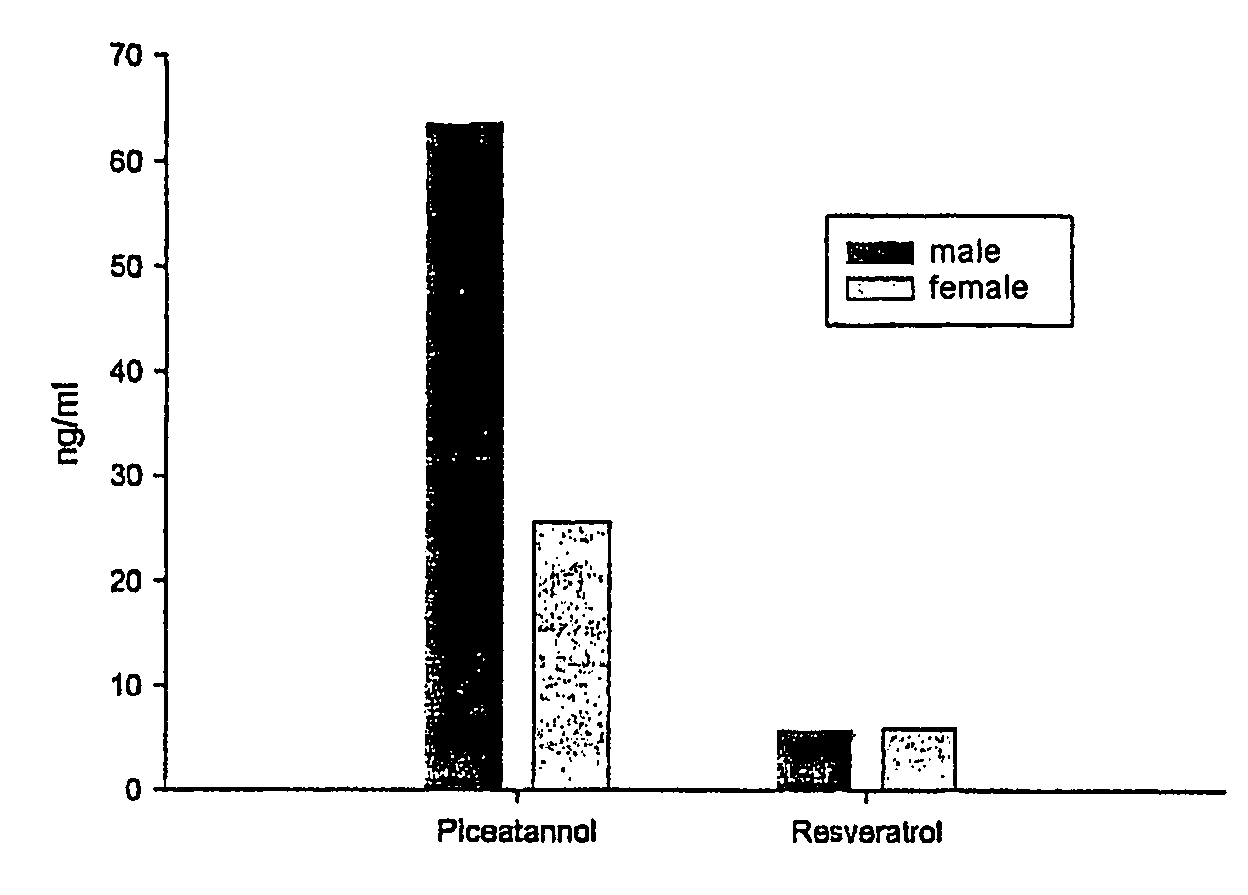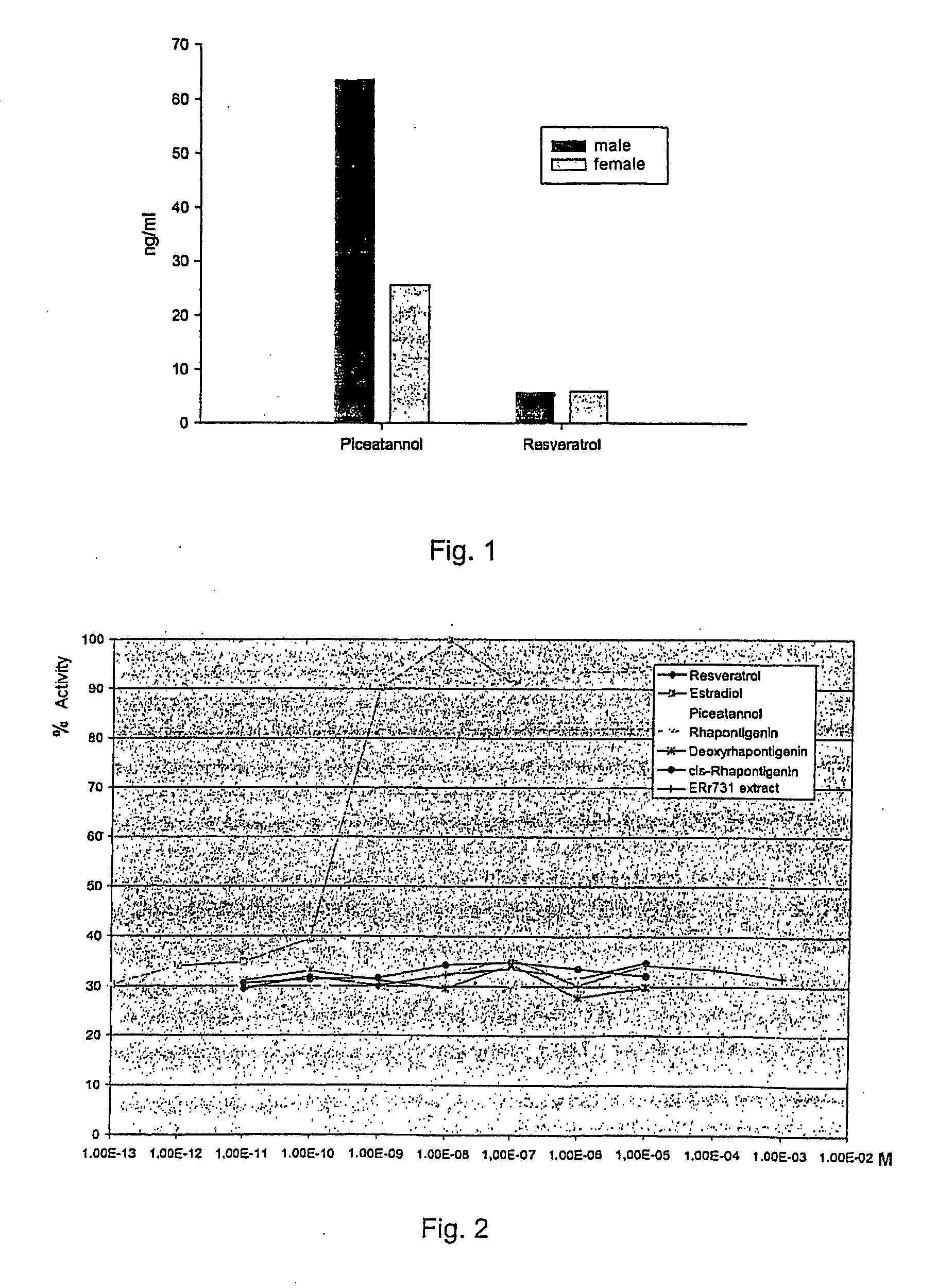Dosage Forms of Active Ingredients Containing Hydroxystilbene for Treating Menopausal Complaints
- Summary
- Abstract
- Description
- Claims
- Application Information
AI Technical Summary
Benefits of technology
Problems solved by technology
Method used
Image
Examples
preparation example 1
Preparation of the Dry Extract ERr 731 from Rhapontic Rhubarb Root with an Aqueous Calcium Hydroxide Solution
[0122]A dry extract is prepared from rhapontic rhubarb root employing the following:
Drug (radix rheum rhaponticum)50.0 kgCalcium oxide 5.0 kgPurified water190.0 kg Acetic acid (as necessaryto adjust the required pH)
[0123]The yield which can be achieved in this case is between 2 and 3 kg per 50 kg of drug.
[0124]The preparation takes place in the following steps:
a) Firstly 5 kg of calcium oxide are introduced into a plastic tub and made into a slurry with 20 kg of purified water. The formation of calcium hydroxide (quicklime) which takes place under these conditions leads to a large rise in temperature of the solution. The calcium hydroxide can therefore be used further only after cooling. The temperature of the solution is then 30° C. to 35° C.
b) 50 kg of drug are introduced into a mixer, and the abovementioned quicklime is added. In order to remove the quicklime as completely...
preparation example 2
Preparation of a Dry Extract from Rhapontic Rhubarb Root with Various Organic Solvents
[0128]The constituents mainly detectable in the rhapontic rhubarb root used as drug here belong to the group of hydroxystilbenes. Present from this group in the roots are rhaponticin (Rh) with a content of about 6% and deoxyrhaponticin (DRh) with a content of about 4%.
[0129]It is possible by exposure to the solvent systems indicated below, in a 100-fold quantity at room temperature for 10 minutes with shaking or stirring, to extract the proportions summarized below:
Ethanol 86%Rh100.8%DRh99.5%Ethanol 15%Rh77.1%DRh75.5%AcetoneRh88.3%DRh96.6%Water, alkalineRh75.5%(pH 11,DRh60.5%adjusted withCaO solution)
[0130]No useful results were achieved with heptane.
[0131]The respective yields of crude extracts in proportions by mass (based on drug employed) are as follows:
Ethanol 86%35.5%Ethanol 15%32.2%Acetone21.4%Heptane 0%Water, alkaline 4.5%
[0132]Extraction of rhapontic rhubarb root with ethanol-water mixtur...
formulation example 1
Production of a Solid Dosage Form—Minitablet
1. Production of the Tablet Core:
[0136]A solid tablet core is produced using the following active ingredients and ancillary substances in the stated ratios of amounts (P=parts by weight). The ingredients are mixed and tabletted in three different ways:
a) Tablet Core Formulation:
[0137]
Purified dry extract according to3.6Ppreparation example 1from rhapontic rhubarb root (ERr 731 ®)Microcrystalline cellulose (e.g. Avicel ®)57.0P (±40%)Sorbitol8.0P (±40%)Talc2.5P (±40%)Makrogol 6000 (polyglycol)1.6P (±40%)Polyvidone (K value about 25, e.g. Kollidon ® 25)1.6P (±40%)Sodium dodecyl sulfate (e.g. Texapon ® K 12)0.5P (±40%)Magnesium stearate (vegetable)0.8P (±40%)75.6P (±40%)
[0138]It is possible by varying the weighed amount of ERr 731® and / or varying the amount of microcrystalline cellulose to obtain any desired ERr 731® contents in the untreated core (such as, for example, 2, 4, 6, 8, 10, 12 mg per tablet).
b) Mixing of Drug and Carrier
[0139]Mixin...
PUM
| Property | Measurement | Unit |
|---|---|---|
| Percent by mass | aaaaa | aaaaa |
| Percent by mass | aaaaa | aaaaa |
| Percent by mass | aaaaa | aaaaa |
Abstract
Description
Claims
Application Information
 Login to View More
Login to View More - R&D
- Intellectual Property
- Life Sciences
- Materials
- Tech Scout
- Unparalleled Data Quality
- Higher Quality Content
- 60% Fewer Hallucinations
Browse by: Latest US Patents, China's latest patents, Technical Efficacy Thesaurus, Application Domain, Technology Topic, Popular Technical Reports.
© 2025 PatSnap. All rights reserved.Legal|Privacy policy|Modern Slavery Act Transparency Statement|Sitemap|About US| Contact US: help@patsnap.com



